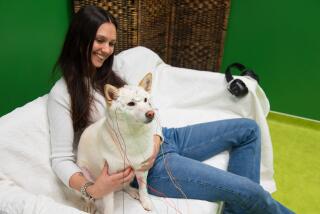Scientists do MRI scans on dogs, asking: What are they thinking?
- Share via
MRI machines have all kinds of helpful uses like telling us what’s wrong with the tissues deep inside our bodies and helping researchers understand the brain’s empathy response. But now, scientists at Emory University in Atlanta are turning to the MRI machine to answer one of life’s great mysteries, at least for canine enthusiasts: What do dogs think about?
And do they really love us, or do they just love our food?
The scientists don’t know the answer yet, but they may know soon. In a new paper to be published in PLoS One on Friday, the Emory research team showed that it is possible to train a dog to climb into an MRI tunnel and stay still long enough for the machine to do a full scan of its brain.
“Nobody as far as I know had ever captured images of a dog’s brain that wasn’t sedated,” said Gregory Berns, lead researcher on the paper and professor of neuroeconomics at Emory in a video about the project. “This was a fully awake, unrestrained dog and here we had a picture, for the first time ever, of her brain. It was incredible.”
In the first experiments with dogs in an MRI machine, the researchers compared the response in the dog’s brain when it was shown a hand signal that meant it would get a hot dog (left hand up), and the response to a signal that meant it would not get a hot dog (both hands pointing toward each other horizontally).
If that doesn’t sound that exciting, don’t worry. In an interview with the Los Angeles Times, Berns said the first experiment was really just a proof of concept, to see how to go about doing a brain scan on a dog.
“It was purposely very simple because we didn’t know it would work,” he said. “We had to kind of pick a task that we could know what should happen.”
But it did work. Next, the researchers can use canine MRI scans to answer more interesting questions.
For example, Berns said, they might explore whether dogs have empathy for owners by showing the dogs pictures of their owners being poked with a pin and seeing whether that triggers a pain response in the dog’s brain. They can also determine whether dogs process human language as arbitrary sound or if they have neural structures that respond to the deeper manner of language. They can see if dogs recognize their owners by sight or by smell.
“There are a million questions we can ask, if we can figure out the right way to ask them,” said Berns.
So far, Berns and his team have put two dogs into the MRI machine. Both dogs were trained to go into the machine on their own and to hold still for the 10 to 15 seconds it takes for the machine to complete a scan without the use of restraints.
The hardest part for the dogs, said Berns, was getting over the loud screeching sound the machine makes when it takes a scan. To overcome that, the researchers fitted the dogs with earmuffs and played the noise of the MRI over loudspeakers in the lab even before the MRI started so that the dogs wouldn’t be startled when the machine started making the sound.
“Ultimately our goal is to understand the human/dog relationship from the human perspective,” said Berns. “People believe their dog understands and loves them, and we want to know what the dog is thinking and processing. The simplest question we can answer soon is whether it is all an act -- whether they act all cute and stuff to get food, or is there something more than that.”
For the record, 8:05 a.m. May 8: A previous version of this post misspelled Emory University as Emery.
ALSO:
Solar-powered catamaran goes around the world in 584 days
3-D holographic conferencing is real? Help me Obi-Wan Kenobi!
Parents, men, young people more likely to use phone for searches







